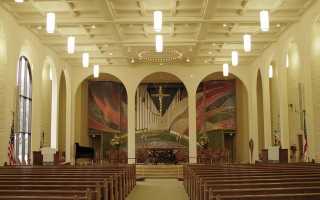Tannoy improves intelligibility at St Barnabas on the Desert
Published: WORSHIP

WORLD: CCS Presentation Systems recently designed and installed a new Tannoy sound reinforcement system into the St Barnabas on the Desert Episcopal Church in Scottsdale, Arizona.
Following the donation of a new organ, the church opted to completely renovate the sanctuary. As church leadership would now be using the organ during services, they required a system that could deliver dramatically improved vocal intelligibility.
The 350-seat sanctuary features columns and arches, a high ceiling and a raised circular altar with choir risers and a pipe organ located directly behind it. ‘The sanctuary was originally designed to have the acoustic principles and characteristics of larger cathedrals,’ explained Rod Andrewson, chief engineer at CCS Presentation. ‘As a result, it’s a highly reverberant space that has been plagued with vocal intelligibility issues for decades. Over the years a number of acoustical treatments had been applied in an attempt to resolve the problem, with little to no success.
‘After we viewed the church we were told that the sanctuary would be stripped of all acoustic treatments and I knew we had a real challenge on our hands,’ he admitted. ‘As a matter of fact I contemplated not having anything to do with the project at all. But before walking away, I wanted to do a little research.’
Mr Andrewson notes that he had successfully implemented Tannoy QFlex digitally steerable arrays in other applications, and resolved to apply them to this project with the main goal being to focus as much sonic energy on the audience as possible while keeping it away from reflective surfaces.
The church needed the new system to be as unobtrusive as possible, and the Qflex speakers’ slim profile proved to be a persuasive attribute. ‘We showed them that we could very precisely divine and steer the acoustical imprint on the audience,’ said Mr Andrewson. ‘When we demonstrated the QFlex speakers and Vnet software to our client, it was very clear that none of our competition had even considered doing the same. I think that demo was, hands down, what won us the job.’
The system comprises two QFlex 40 self-powered loudspeakers mounted on left and right columns approximately 6m in front of the alter, whilst Tannoy’s Vnet digital processing and network protocol is hosted on a PC located in the system’s rack room. This is then linked to the loudspeakers via a Vnet USB and an RS232 interface. As such, both main loudspeakers are acoustically profiled and individually optimised, whilst a control panel allows Vnet parameters to be viewed and adjusted – including overall system status as well as specific component performance parameters.
Although the QFlex/Vnet combination handles the vast majority of the church’s coverage needs, a few zones needed further support. To solve this, Tannoy’s Di5 compact loudspeakers were discretely mounted left and right to cover the narthex in the very front area. A further two column-mounted Di5s are utilised to extend coverage to the choir, which is located behind the alter, with one more for the pulpit for ‘preview and confidence’.
‘Designing a system for a reverberant space with no acoustic treatment is outside the norm, but was made possible with QFlex,’ concluded Mr Andrewson. ‘The church members and leadership are extremely pleased with the end result.’
